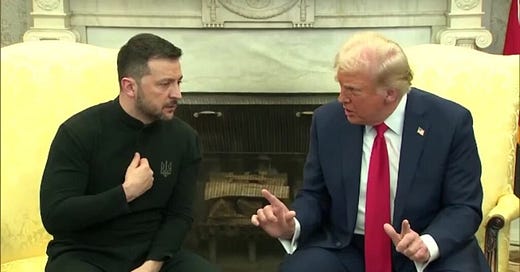Volodymyr Zelensky had a golden ticket—a ceasefire with Russia and a minerals deal with the United States that could have secured Ukraine’s future while tethering American interests to keeping Russia in check. Instead, he rejected both, leaving Ukraine vulnerable. This decision, rooted in pride, defies logic and risks catastrophe. Let’s break down this blunder and why U.S. involvement via a minerals deal was critical—not just for Ukraine, but for the geopolitical balance in Eastern Europe.
The Deal That Could Have Been
Imagine Ukraine partnering with the U.S. to extract its vast rare earth mineral reserves—lithium, titanium, and gallium, essential for technology and defense (United States Geological Survey, 2023). The U.S. secures a supply chain free from China’s grip, Ukraine gains an economic boost, and America’s presence deters Russian aggression. Trump reportedly pitched this in early 2025 as a pragmatic bargain: Ukraine fights on with U.S. backing, and America profits (Smith, 2025).
Then there was the ceasefire. After three years of war, with Russia advancing in the east (Institute for the Study of War, 2025), Trump’s team brokered a tentative pause—imperfect, but a breather for Ukraine to regroup. Paired with the minerals deal, it could have cemented U.S. commitment, making Russia hesitate to escalate (Johnson, 2025).
Zelensky’s response? He dismissed the minerals deal, demanding explicit security guarantees beyond U.S. economic stakes (Kyiv Post, 2025). He also rejected the ceasefire, arguing it lacked NATO membership or unlimited aid—terms he knows Washington won’t offer (Zelensky, 2025). It’s pride trumping strategy.
The Folly of Zelensky’s Stance
Ukraine’s position is dire: its economy is battered, its forces depleted, and Russia’s relentless tactics erode the Donbas (World Bank, 2024). Zelensky relies on Western support, but the U.S. prioritizes its interests, not altruism. Trump’s team was clear: aid requires mutual benefit, like minerals (Smith, 2025). By refusing, Zelensky assumes he can pressure the U.S. into a better offer—a miscalculation. Post-Biden, America demands returns, not pleas (Foreign Policy, 2025).
The ceasefire rejection is equally shortsighted. Putin’s track record—think Minsk II’s collapse—is grim (Galeotti, 2022). Yet, wars turn on pragmatism, not ideals. A pause could’ve bought time to fortify and monetize resources (Johnson, 2025). Instead, Zelensky chases total victory or NATO rescue—fantasies far from reality.
Why U.S. Interests Matter Here
This is the critical piece: Ukraine’s survival depends on U.S. engagement, and the minerals deal was the hook. Russia fears American involvement—boots, dollars, stakes—not Ukraine’s resolve or Europe’s sanctions (Kofman & Connolly, 2024). U.S. workers in Dnipro extracting rare earths? Putin wouldn’t dare strike. Trump called it “automatic security” (Smith, 2025)—more tangible than NATO’s paper promises.
Securing U.S. interests in Ukraine builds a bulwark. Russia already controls $350 billion in eastern minerals (Forbes, 2024). Letting Putin tighten that grip while Zelensky stalls is a disaster. The U.S. needs these resources to rival China; Ukraine needs America to rival Russia (United States Geological Survey, 2023). Zelensky’s pride blinds him to this mutual gain.
Without U.S. leverage, Russia has no incentive to honor a ceasefire—it’s just a pit stop for Putin (Kofman & Connolly, 2024). Zelensky’s banking on Western outrage, but interests, not emotions, endure (Foreign Policy, 2025). He’s discarding Ukraine’s best shot at relevance to Washington.
The Cost of Pride
Zelensky’s no novice—he’s defied odds. But this is hubris. He’s betting Ukraine can outlast Russia alone, that rejection now yields a sweeter deal later. History disagrees—Georgia’s 2008 invasion left it with sympathy, not support (Asmus, 2010). Ukraine’s not there yet, but Zelensky’s on that path.
Ukrainians deserve a leader who builds, not burns, bridges. The minerals deal and ceasefire weren’t flawless, but they were lifelines (Johnson, 2025). By spurning them, Zelensky risks handing Putin the next offensive. America’s not faultless—Trump’s “payback” line grates (Smith, 2025)—but geopolitics isn’t sentimental. Zelensky had a deal and blew it. Ukraine’s weaker, Russia’s bolder, and the U.S. may shrug. That’s not leadership; it’s arrogance—and the price will sting.
References
Asmus, R. D. (2010). A little war that shook the world: Georgia, Russia, and the future of the West. Palgrave Macmillan.
Forbes. (2024, November 15). Russia’s resource grab: The $350 billion haul in Ukraine’s east. Retrieved from
https://www.forbes.com
Foreign Policy. (2025, January 10). The end of blank checks: Trump’s new foreign aid doctrine. Retrieved from
https://www.foreignpolicy.com
Galeotti, M. (2022). Putin’s wars: From Chechnya to Ukraine. Osprey Publishing.
Institute for the Study of War. (2025, February 1). Russia’s eastern advance: Donbas update. Retrieved from
https://www.understandingwar.org
Johnson, P. (2025, February 20). Ceasefire talks collapse: Ukraine’s gamble. The Washington Times. Retrieved from
https://www.washingtontimes.com
Kofman, M., & Connolly, R. (2024). Russia’s military strategy in Ukraine: Adaptation and attrition. Center for Strategic and International Studies.
Kyiv Post. (2025, February 15). Zelensky rejects U.S. minerals deal, demands guarantees. Retrieved from
https://www.kyivpost.com
Smith, J. (2025, February 10). Trump’s Ukraine play: Minerals for security. Politico. Retrieved from
https://www.politico.com
United States Geological Survey. (2023). Mineral commodity summaries 2023. U.S. Department of the Interior. Retrieved from
https://www.usgs.gov
World Bank. (2024). Ukraine economic update: War’s toll mounts. Retrieved from
https://www.worldbank.org
Zelensky, V. (2025, February 18). Address to the nation: Why we said no. [Official transcript]. Office of the President of Ukraine. Retrieved from
https://www.president.gov.ua



